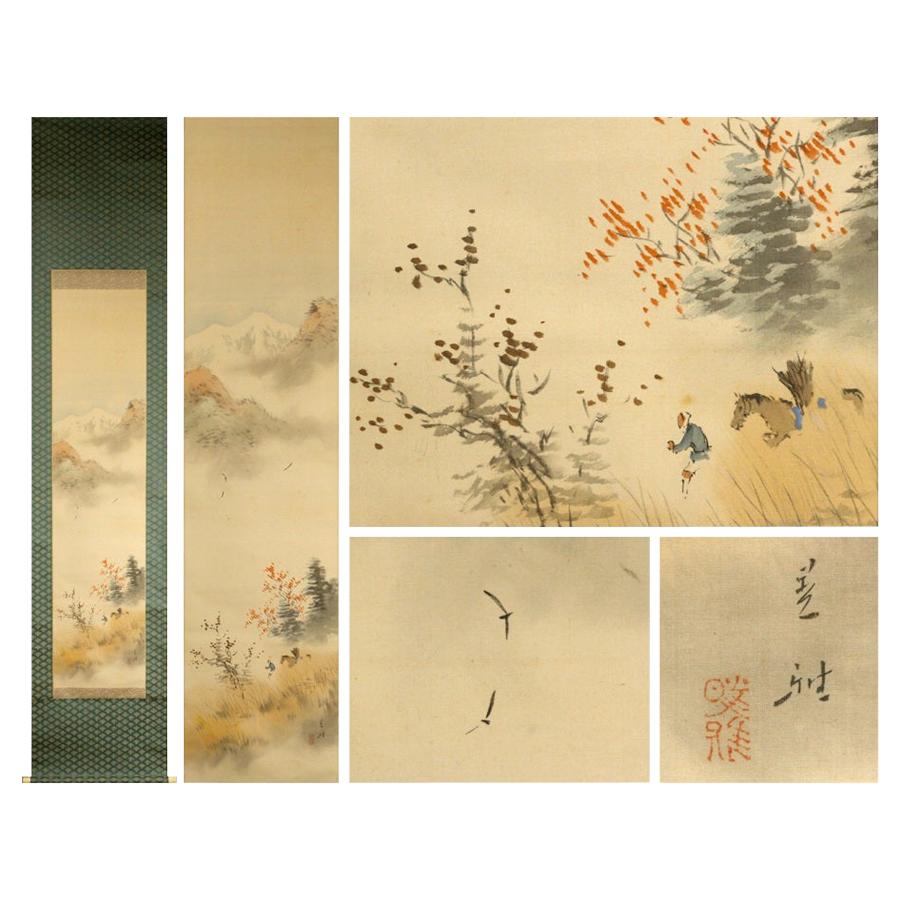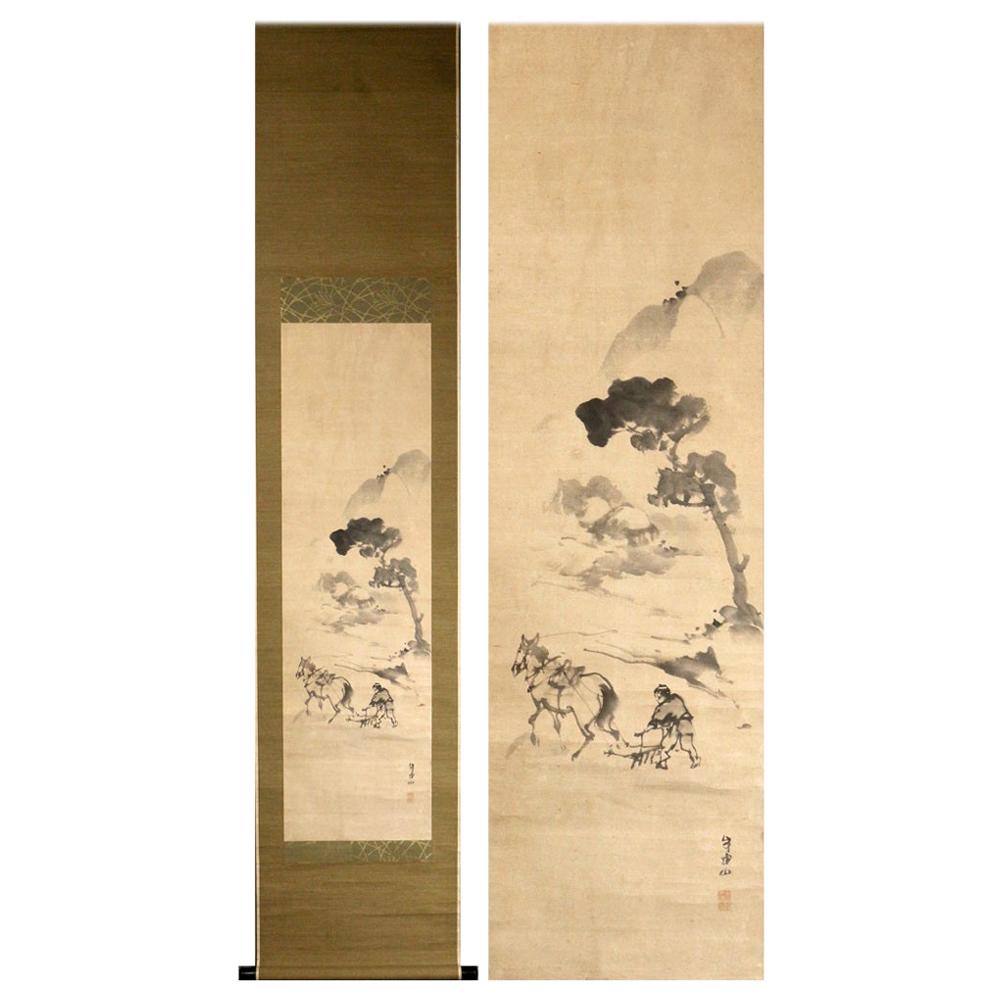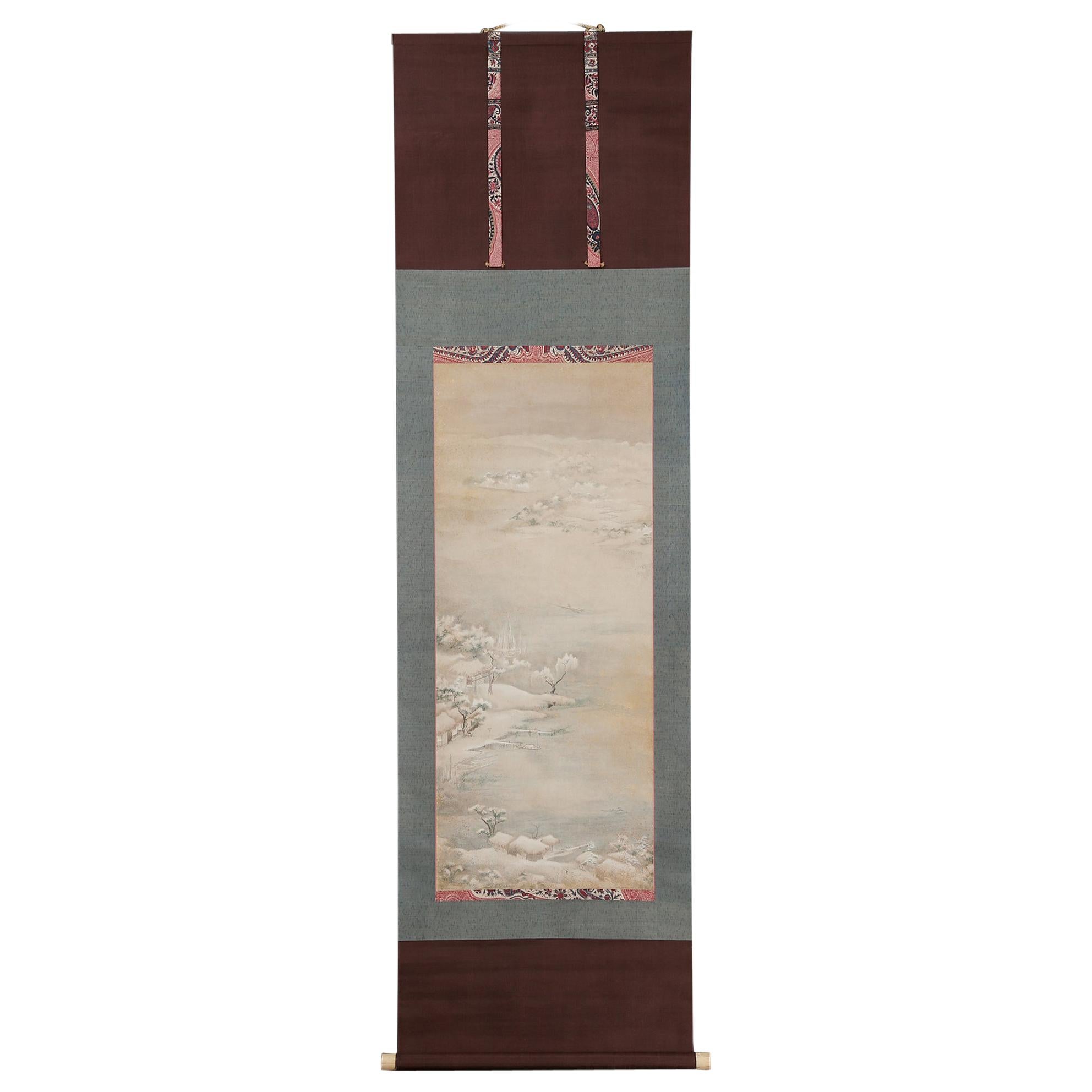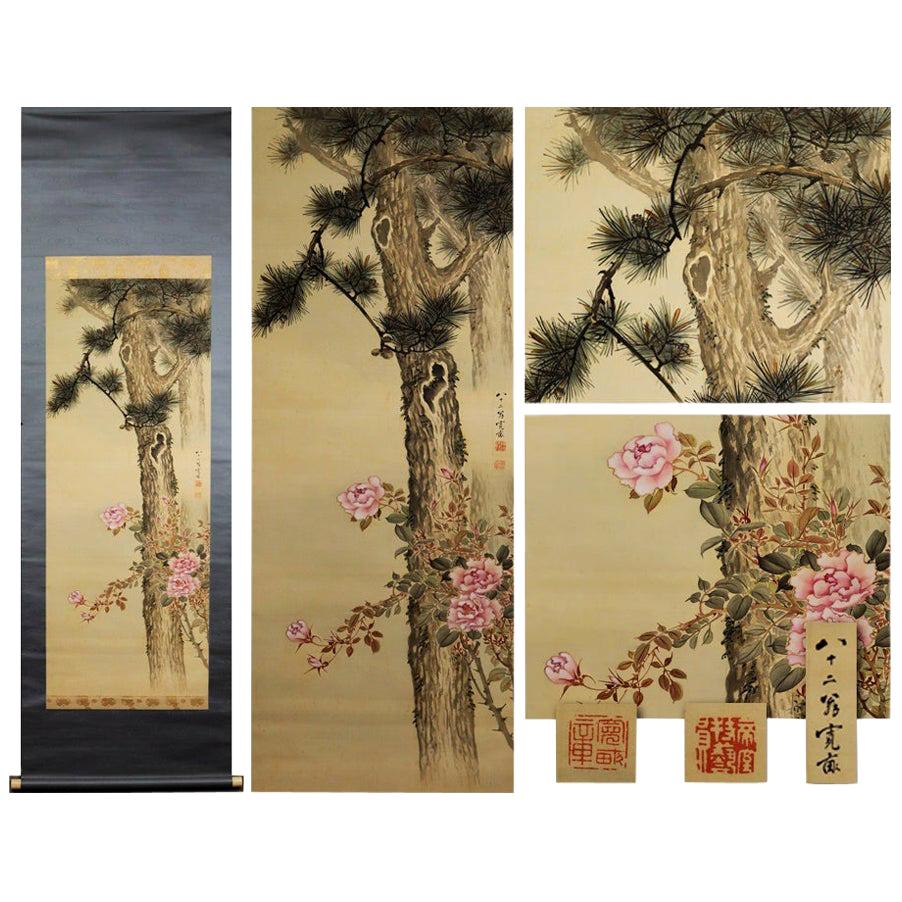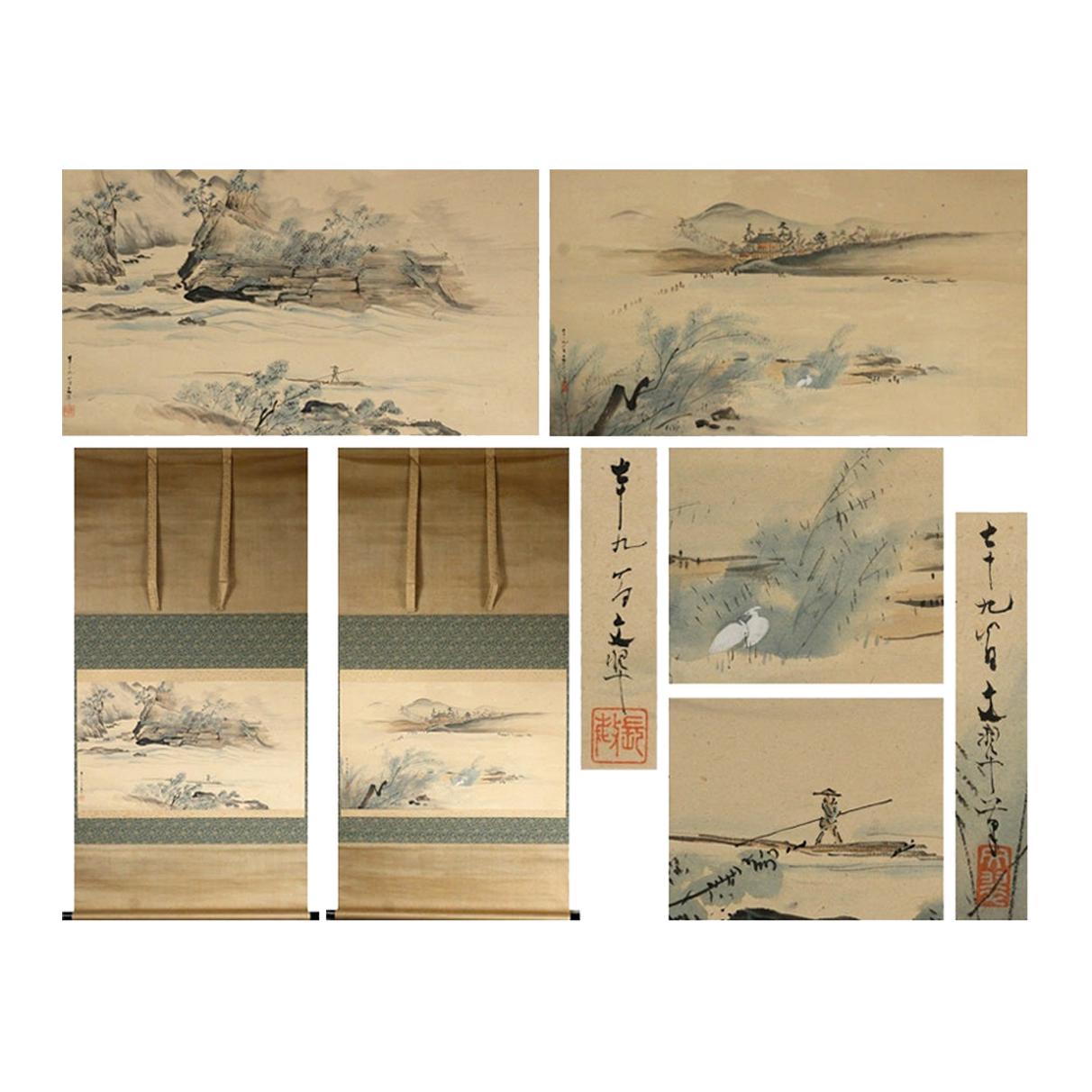Items Similar to Waterfall and Bird Scene Meiji Period Scroll Japan 19c Artist Marked
Want more images or videos?
Request additional images or videos from the seller
1 of 6
Waterfall and Bird Scene Meiji Period Scroll Japan 19c Artist Marked
About the Item
As you can see, this is a Japanese painting by Aoe,
which depicts the beautiful "Aoba Takiyanzu" with beautiful fresh greenery.
¦ Paper books and handwriting.
¦
There are some discolorations in the state era.
¦ Shaft dimensions / approx. 197.0 cm x approx. 45.0 cm.
¦ Paper size / approx. 133.0 cm x approx. 34.0 cm.
¦ Signs / There are inscriptions and seals as you can see.
¦ Box / none.
- Dimensions:Height: 77.56 in (197 cm)Width: 17.72 in (45 cm)Depth: 0.04 in (1 mm)
- Style:Meiji (Of the Period)
- Materials and Techniques:
- Place of Origin:
- Period:
- Date of Manufacture:19th Century
- Condition:Wear consistent with age and use. ■ Paper books and handwriting. ■ There are some discolorations in the state era. ■ Shaft dimensions / approx. 197.0 cm x approx. 45.0 cm. ■ Paper size / approx. 133.0 cm x approx. 34.0 cm. ■ Signs / There are inscriptions and seals as you can see.
- Seller Location:Amsterdam, NL
- Reference Number:
About the Seller
5.0
Gold Seller
These expertly vetted sellers are highly rated and consistently exceed customer expectations.
Established in 2015
1stDibs seller since 2019
158 sales on 1stDibs
Typical response time: 11 hours
- ShippingRetrieving quote...Ships From: Amsterdam, Netherlands
- Return PolicyA return for this item may be initiated within 14 days of delivery.
More From This SellerView All
- Autumn Scene Meiji Period Scroll Japan 19c Artist Marked Nihonga StyleLocated in Amsterdam, Noord HollandAs you can see, Japanese painting late autumn Akino map / with box. It is a beautiful work that depicts the melancholy scenery of Akino, which is unique to late autumn , and is com...Category
Antique Mid-19th Century Japanese Meiji Paintings and Screens
MaterialsSilk
- Farming Rice Fields Scene Meiji Period Scroll Japan 19c Artist MarkedLocated in Amsterdam, Noord HollandThe simple country side life is the ideal of the Oriental scholar. As you can see, the Kishi Renzan agricultural rice field working painting / box is included. Agricultural rice fields are worked using horses...Category
Antique Mid-19th Century Japanese Meiji Paintings and Screens
MaterialsSilk
- Hiroshige Scene Meiji Period Scroll Japan 19c Artist Marked Nihonga StyleLocated in Amsterdam, Noord HollandDen Nidai Hiroshige "Edo Suburbs Famous Place Sumida River Upstream Map" paper book watercolor hanging scroll with box Size Axis · · · Length 183cm, width 52.8cm Inside · · · Lengt...Category
Antique Mid-19th Century Japanese Meiji Paintings and Screens
MaterialsSilk
- Lake Awasaru Scene Meiji Period Scroll Japan 19c Artist Marked Nihonga StyleLocated in Amsterdam, Noord HollandAs you can see, it is a Japanese painting "Lake Suwa Asaharu" figure / co-box. It is a "Lake Suwa Asaharu" figure with gentle sunlight, and it is a very tasty work combined with a ...Category
Antique Mid-19th Century Japanese Meiji Paintings and Screens
MaterialsSilk
- Blossom and Tree Scene Meiji Period Scroll Japan 19c Artist Araki KanpoLocated in Amsterdam, Noord HollandIf it is good enough for the Japanese emperor :) The painting's inscription says that it was painted in the artist's 82nd year, which would be 1913. In the early Meiji Period following the Buncho ideal of hasshu kengaku ('learning eight schools'), Kanpo expanded his talents to incorporate Western painting techniques and began studying oil painting with Kawakami Togai (1827-1881) and Kunisawa Shinkuro (1847-1877). He achieved notable recognition as an oil painter and apparently was awarded the honor of painting a portrait of the Empress Dowager. Later Kanpo returned to Nihonga and continued to receive numerous honors for his work. He received a silver medal (2nd place) at the Tokyo Prefecture Crafts Competition in 1887; 2nd place with a painting of peacocks...Category
Early 20th Century Japanese Meiji Paintings and Screens
MaterialsSilk
- Nihonga Pair Landcape Scene Meiji Period Scroll Japan 19c Artist SakakibaraLocated in Amsterdam, Noord HollandAs you can see, Fumi Sakakibara brush-colored landscape map with double width / box. The light and calm colored landscape drawings applied to each are ...Category
Antique Late 19th Century Japanese Meiji Paintings and Screens
MaterialsSilk
You May Also Like
- Japan Scroll Painting, Meiji PeriodLocated in Pasadena, CAThis is a wonderful example of a Meiji Period screen painting of Japanese Tanuki or racoon dogs in a landscape. The Tanuki is considered to be a mythical creature Japanese culture. T...Category
Antique Late 19th Century Japanese Meiji Paintings and Screens
MaterialsFabric, Paint
- Japanese Gohonzon Buddhist Calligraphy Mandala Scroll Meiji PeriodLocated in Atlanta, GAA Japanese sumi ink calligraphy Buddhist mandala mounted as a paper hanging scroll known as Kakejiku or sometimes Moji mandala. Termed as gohonzon in Japanese, it is a venerated object within Nichiren Buddhism (Hokkeshu; lotus sect). The originally concept was developed by the 13th century Buddhist priest Nichiren to guide the energy of the devotional chanting to...Category
Antique Early 1900s Japanese Meiji Paintings and Screens
MaterialsPaper
- Japanese Gohonzon Buddhist Calligraphy Mandala Scroll Meiji PeriodLocated in Atlanta, GAA Japanese sumi ink calligraphy Buddhist mandala mounted as a paper hanging scroll known as Kakejiku or sometimes Moji mandala. Termed as gohonzon in Japanese, it is a venerated object within Nichiren Buddhism (Hokkeshu; lotus sect). The originally concept was developed by the 13th century Buddhist priest Nichiren to guide the energy of the devotional chanting to...Category
Antique 1890s Japanese Meiji Paintings and Screens
MaterialsPaper
- Japanese Meiji Riverside Scroll Painting, c. 1900Located in Chicago, ILAlthough western painting was initially embraced during Japan’s Meiji period (1868-1912), artists brought on a revival of traditional painting styles as they sought to create a modern Japanese style with roots in the past. This exquisite hanging scroll demonstrates the preference for soft layering of gray tones with judicious use of color. The landscape is rendered in soft ink washes that subtly distinguish between water, mountain, and sky. The scroll painting...Category
Early 20th Century Japanese Meiji Paintings and Screens
MaterialsPaper
- Meiji Period Japanese Screen Pair, One Hundred Birds by Hasegawa GyokujunLocated in Kyoto, JPOne hundred birds Hasegawa Gyokujun (1863-1921) Meiji period, circa 1900. Ink, color and gofun on silk. Dimensions of each screen: H. 170 cm x W. 190 cm (67’’ x 75”) Despite the title, well over 100 birds are represented in this pair of two-fold Japanese screens (the title functions figuratively to convey the idea of a large number). The monumental work is rendered with a comprehensive and highly complex composition which is exquisitely executed and meticulously colored. More a celebration of naturalism than the traditional “One Hundred Birds” paintings which originated in China. This was a subject matter known for its auspicious meaning as much as its actual depiction of nature. These paintings generally had a phoenix (occasionally peacocks) placed in the center, and the other birds paying homage to it. In this quintessentially Japanese scene painted by Gyokujun, a couple of long-tailed birds modeled after paradise flycatchers are included; these are traditional auspicious motifs in Oriental bird and flower painting and denote themes such as celebration and enduring generations. In addition there is the playful inclusion of single exotic parrot. Even so, the vast majority of the birds and flowers are native to Japan. Reading the scene from right to left, from spring through to autumn, the overwhelming sense is one of movement and haste. It is almost as if the birds are in a race, with the fleetest leading the way forward. Although these native birds were commonly drawn amongst artists of the Shijo school, rarely were they painted with such drama and dynamism. It is not strictly a depiction of sketched birds whose manner was faithfully handed down through the traditions of the Shijo school. Rather we see Gyokujun seeking and achieving new expressions in the heart of the turbulent Meiji period. Hasegawa Gyokujun (1863-1921) was born in Kyoto. He was the eldest son of Hasegawa Gyokuho, a Shijo school painter who studied under Matsumura Keibun. Gyokujun studied painting under his father and became a prominent member of the Kyoto painti ng world from a young age. In 1891 he established the ‘Young Painters Social Club’ along with Takeuchi Seiho, Miyake Gogyo and Taniguchi Kokyo. Also in 1891 he was selected as a judge of the Great Private Paintings Exhibition along with Takeuchi Seiho, Yamamoto Shunkyo...Category
Antique Early 1900s Japanese Meiji Paintings and Screens
MaterialsSilk, Wood
- Japanese Meiji Hanging Scroll of Ayu Fish, c. 1850Located in Chicago, ILAlthough Western painting was initially embraced during Japan’s Meiji period (1868–1912), artists brought on a revival of traditional painting styles as they sought to create a moder...Category
Antique Mid-19th Century Japanese Meiji Paintings and Screens
MaterialsPaper, Silk
Recently Viewed
View AllMore Ways To Browse
Birds Japan
Silk Birds
Silk Bird
Asian Midcentury Artist
Japanese Bird Painting
Bird Silk Art
Antique Japanese Scrolls
Japanese Antique Scroll
Japanese Antique Scrolls
Japanese Painting With Birds
Antique Artist Box
Antique Waterfall
Japanese Scroll Art
Antique Paper Scrolls
Antique Paper Scroll
Waterfall Antique Furniture
Waterfall Furniture Antique
Waterfall Antique Furniture Waterfall Furniture
